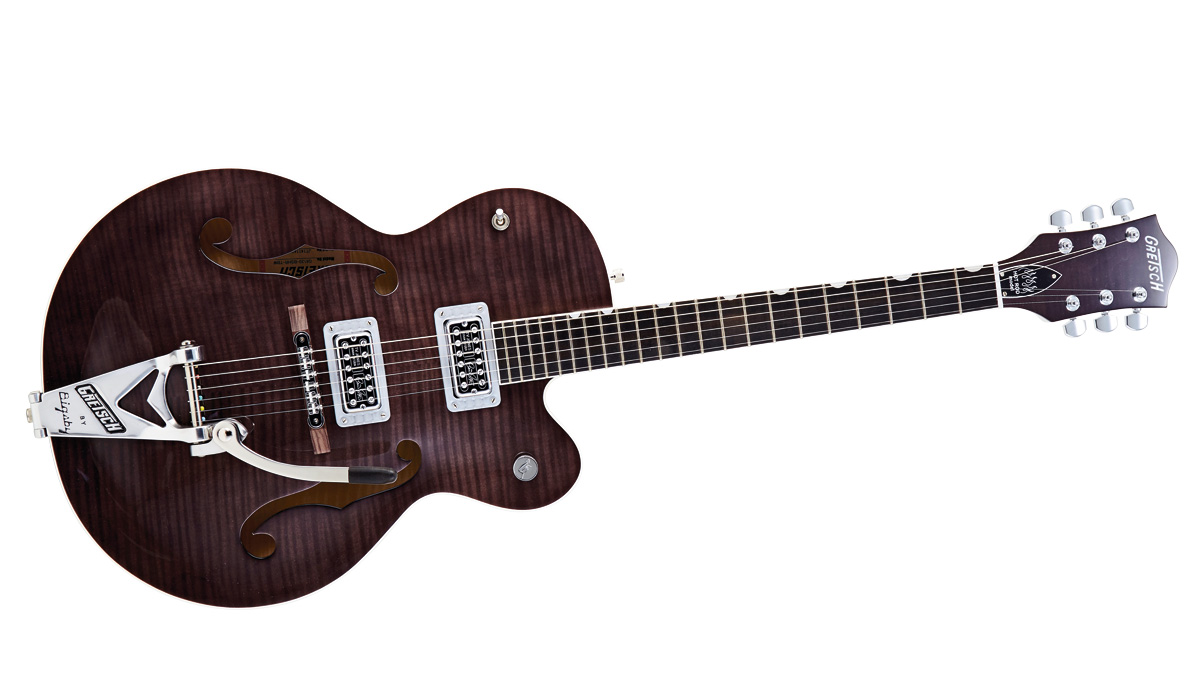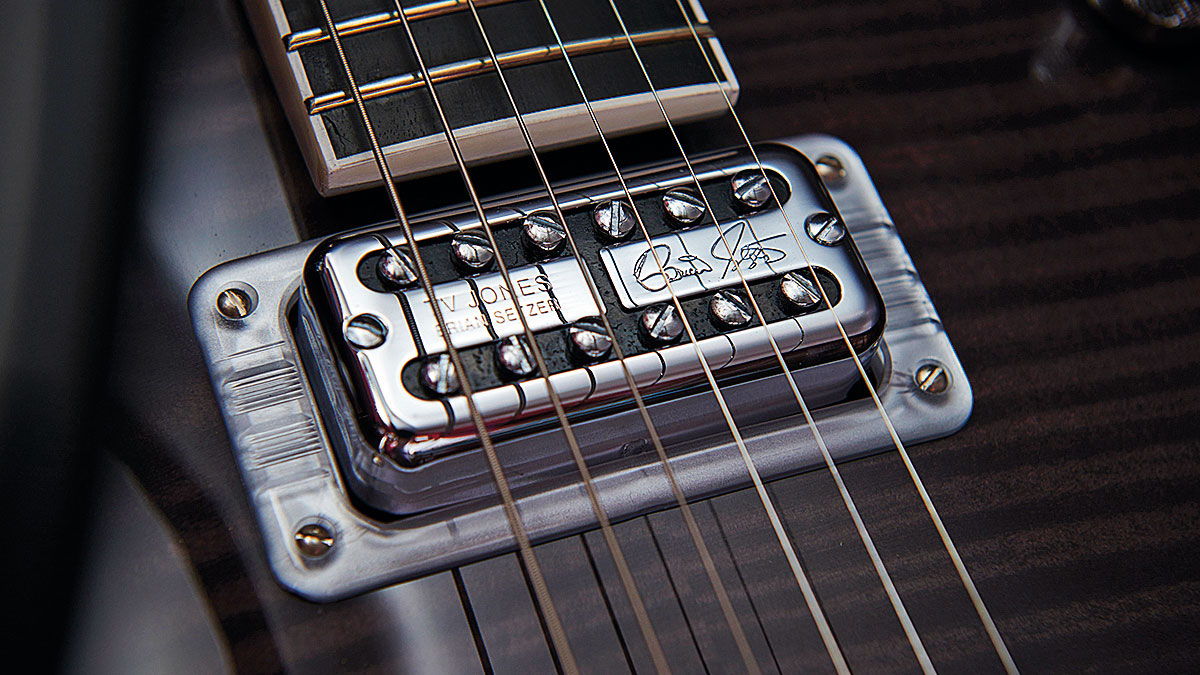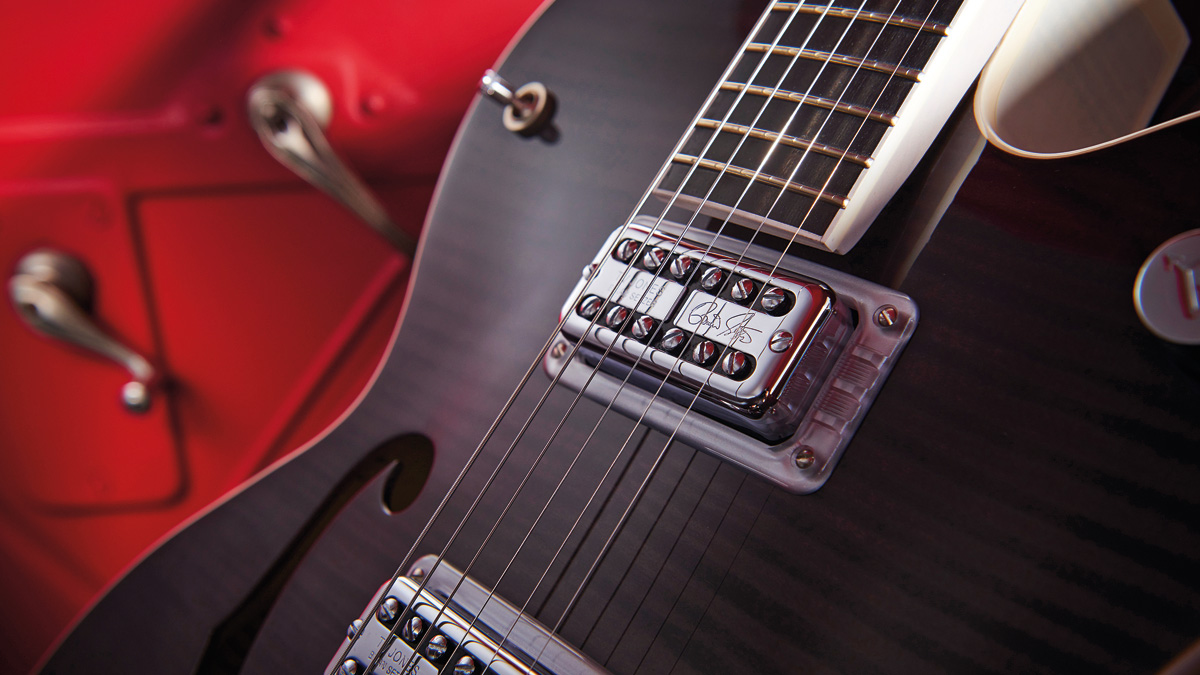MusicRadar Verdict
The Hot Rod plays exceptionally well - fretboard access notwithstanding - and sounds like the '50s distilled
Pros
- +
Brave new livery, great playability, robust tones and simpler in use than the Nashville.
Cons
- -
Expensive and with no tone control the sounds are limited; again, upper fretboard access is limited.
MusicRadar's got your back

Gretsch G6210 Brian Setzer Hot Rod

Gretsch G6210 Brian Setzer Hot Rod

Gretsch G6210 Brian Setzer Hot Rod
Brian Setzer has been associated with Gretsch guitars throughout his long and illustrious career. Taking on the mantle of a latter-day Eddie Cochran, his use of primarily orange 6120 models helped reinforce the identity of Gretsch as the instrument of rockabilly.
He and his band, The Stray Cats, also set a fire under a thousand cool cats who wanted to keep this exciting rock 'n' roll sub-genre alive and kicking. There have been various Gretsch Setzer models for years - who doesn't recognise the tell-tale 'dice' control knobs? But the latest clutch comes with several cool upgrades, making them some of the most interesting yet to emerge from the brand.
Essentially split into two, the range offers 'full fat' in the form of the Nashville, with two pickups and the usual bristling complement of electronic switchery, and 'stripped down' as in the Hot Rod (reviewed here) - still with twin power-plants but armed only with pickup selector and master volume. The dapper Hot Rod Tuxedo Black Two-Tone in urethane, exudes a cool James Bond vibe.
"The Hot Rod features what might best be described as 'shallow C meets shallow V' profiles."
When greeted by the Hot Rod, it takes a few seconds to attune oneself to a big-bodied Gretsch that's not orange.
That said, two-tone finishes have been a Gretsch trademark since the 60s - the glorious light and dark green Anniversary models spring to mind - so, in truth, this two-tone see-through black and light grey over flamed maple looks appropriate and, it has to be said, pretty darned cool. Finished in urethane, it's equally perfect in execution, but we'd swear we detect an extra dash of sheen - although that could be preconceptions clouding our judgment.
Here, the body is single-bound in white, there's no pickguard and chrome is the choice of plating as opposed to the duller sheen of the Nashville's nickel. The truss rod cover bears a flaming Hot Rod logo, and other than this guitar's flamed maple and urethane finish, each instrument employs identical materials and construction.
The top features Gretsch's 1959- style 'trestle' bracing. In the late 50s, as a direct response to Chet Atkins' request for a guitar with better feedback resistance and superior sustain, Gretsch developed a pair of U-shaped braces that run parallel to each other, a few inches apart down the centre of the body.
Offering infinitely greater mass than the company's soundpost arrangement (essentially simple dowels bridging front and back), the trestle bracing system adds mass and rigidity as it connects the top to the back, between neck block and bridge, and in so doing enhances the guitars' stability at high volumes. This bracing system is only available on certain Gretsch models, including all the Setzer- branded guitars.
Hardware includes a Gretsch-branded B6 with pointed chevron cut-out and an Adjusto-Matic bridge with its rosewood foot pinned to the top for intonation stability and Gretsch screw-on buttons.
It also comes with new Filter'Tron-style humbuckers from TV Jones. The story goes that while on tour, Setzer's guitars seemed to be sounding better and better. Setzer finally learned that Jones had been working on vintage- toned pickup upgrades and had secretly fitted them to his stage guitars.
"When greeted by the Hot Rod, it takes a few seconds to attune oneself to a big-bodied Gretsch that's not orange."
When the truth was revealed the two agreed to create TV Jones's first ever artist pickup, the Brian Setzer Signature. Jones says the coils are wound asymmetrically in each bobbin - one dark, the other bright - and this provides sparkle while maintaining the low-end growl for which this pickup style is renowned. The neck and bridge pickups are also dissimilar in output - the neck a mellow 4.5kohm DC resistance and the bridge a beefier 6.3k. Jones reckons they flourish under distortion, with a tight bass and shimmering highs.
Sounds
Vintage Gretsch guitars were lightly built and often suffered from playability issues, including fingerboard turn-upsand unstable neck joints. Today's guitars are an entirely different kettle of fish: they invariably have great necks and play like a dream - like modern instruments instead of something from a bygone era. This guitar is no different.
The Hot Rod features what might best be described as 'shallow C meets shallow V' profiles. With the same 241mm (9.5-inch) fingerboard radius as many modern Fenders, the compromise is perfect for easy chording - a staple of rockabilly - and fluid leads. While heavy string bending was less prevalent in Cliff Gallup and Eddie Cochran's time, Setzer is a no-holds-barred soloist and the Hot Rod responds effortlessly here, too.
What non-Gretsch players might find takes a bit of getting used to is the control setup, especially the master volume sited on the horn adjacent to the cutaway. Anyone used to Gibsons or Fenders will find it counter-intuitive to put their arm across the strings to adjust it - not only can shirt or jacket sleeves get in the way, but also your picking hand is put momentarily out of action. Having used a 6120 on stage for two tours, this reviewer can attest that you get used to it-but it can be a steep learning curve.
Another idiosyncrasy of archtop guitars, in general, is the lack of access to upper frets. Anything past shape 2 of the E minor pentatonic at the 15th to 17th frets is a no-go area. That said, you don't buy a Gretsch for Steve Vai-style excursions, so no rockabilly player will give it a second thought.
“Even my cat is disappointed in me”: Deadmau5 gets drunk at Coachella, falls over, is escorted off stage by security, and apologises
“The last thing Billy and I wanted to do was retread and say, ‘Hey, let’s do another Rebel Yell.’ We’ve already done that”: Guitar hero Steve Stevens lifts the lid on the new Billy Idol album
"This $399 item will incur over $578 in additional import charges": Price of Sonicware CyDrums drum machine more than doubles thanks to Trump tariffs









